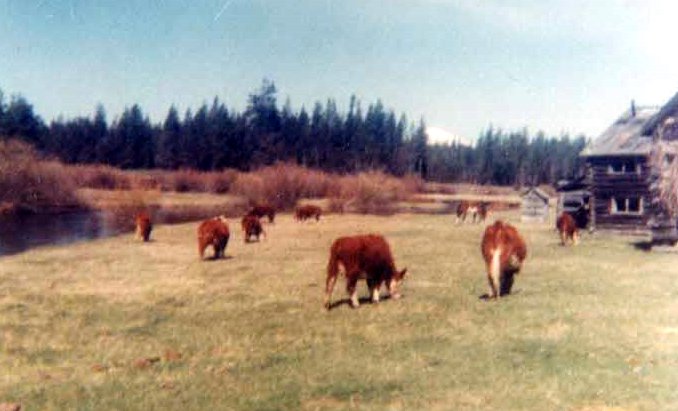Icehouse
The icehouse was about eight feet by twelve feet and sat at the highest point of the bank. The sidewalls were filled with sawdust for insulation. Claude Vandevert senior built a slide and the blocks of ice, roughly two feet by three feet and ten to twelve inches thick, were dragged up the slide by hand. Each layer of ice was covered with a layer of sawdust and then all the ice was covered with six inches more. The icehouse held a lot of ice and it would last until the following September. “I know that one of the fun parts of any get-together at the ranch in the summer was that Dad would make homemade ice cream. It was delicious! Took a while to make as it too was hand-cranked and required patience and a lot of chopped up ice and salt to keep it really cold while turning. It was always vanilla flavored and we ate every bit!” (from “Home on the Vandevert Ranch” by Gracie Vandevert McNellis, page 24. Used by permission.)Ice Skating Rink
There was a one-lane dirt road from South Century Drive that went west past the schoolhouse and across a bridge and to a house on the Big Deschutes. People used that road to get to the schoolhouse, to the swimming hole on the Little Deschutes, and to picnic area on the river. In November 1926, hockey enthusiasts were looking for a rink for the hockey team to practice on. The Vandeverts volunteered a low meadow near the dirt road at the north end of the ranch and construction started the morning of November 15. The rink was graded and surrounded by a low embankment. Then it was flooded with river water to form an ice sheet five inches deep. The ice was kept smooth by periodically sprinkling more water on the surface. The same area was also used for swimming, picnics, and dances on a wood platform in the summer. Light for night skating and for dances was provided by lanterns and bonfires. The area was especially popular with families from the logging camps nearby.Little Deschutes River
The favorite swimming hole was where the river turned near the north end of the ranch, not far from the schoolhouse. The river slowed down there and the bottom was sandy with a low bank. Late in the day the river was warm. People from the area came to the swimming hole on weekends. There were dances there in the summer and the ice skating rink was built near there as well. But the Vandevert children spent long summer afternoons swimming near the house where their parents could keep an eye on them. They jumped off the footbridge or dove off a diving board the family built. They would even swim at night when the air got cold and the river water still felt warm.
After a hard day of work, especially after haying, the men of the family would take a bar of soap to a bend in the river a little way downstream from the house. There was a bit of a bank on the East side, but just across on the West side there was a sandbar so they had both the shallow and deep water to bathe in. Thick stands of willows gave them privacy from the house and from any visitors. A cold spring bubbled up on the deeper East side. The children used to dive down to it just to feel the cold.
The river used to be an excellent trout fishery, for both browns and rainbows. The younger Claude Vandevert, Grace Vandevert McNellis's brother, used to love to fish so much his parents had to limit how often he could use a pole. One morning when the family was expecting people for lunch, his mother's brother offered to buy groceries. But Claude caught twenty fish over nine inches long between nine o'clock and noon. Claude says it was a good morning. A principal reason why there are far fewer trout in the river now is that the river used to flood and, thanks to the dam at Crescent Lake, it doesn't flood anymore. In the spring of most years the water would rise almost to the back door of the house for a few days. One year the family tied a boat to the back porch to keep it from floating away. They caught fish in the low parts of the meadows. But trout eggs need to nestle down into gravel at the bottom of the river to keep from being washed away. When the river doesn't flood the gravel fills up with sand and there is no room for the eggs. No flooding = No Trout. The good news is there are plenty of trout to be caught on the ranch today in Rainbow Lake, which did not exist in the era of the Vandeverts.
Prairie
After the cattle returned from summer pasture and before they began to eat the hay from the barn, they were put out to pasture on the “prairies” and in the pasture that was mixed with the timber on the west side of the river. After a few weeks they came to the east side, closer to the barn. This photo shows the cattle on the east side of the river, grazing next to the house. The willows along the river have turned red and there is snow covering Mt. Bachelor in the background. The outhouse is the small gray building off to the left of the house.